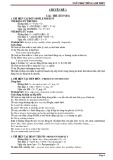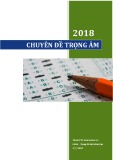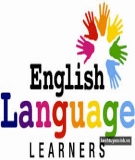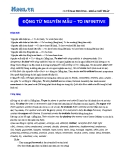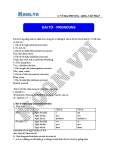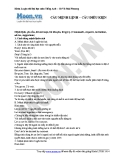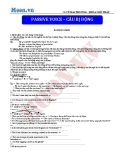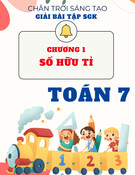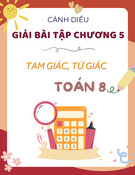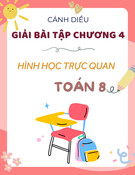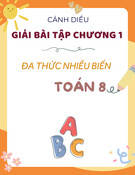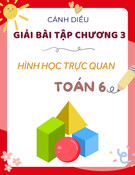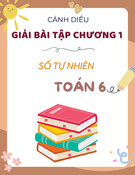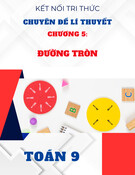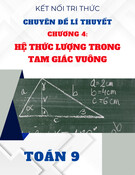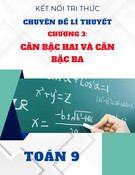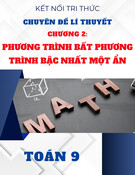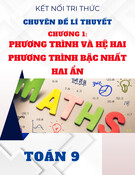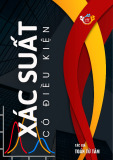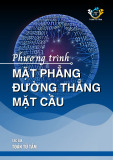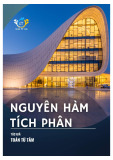
NGUYỄN TIẾN DŨNG
(Founder & Administrator Hội học sinh, sinh viên chuyên Anh)
Fanpage: https://www.facebook.com/groups/hoihocsinhsinhvienchuyenanh
C H U Y Ê N Đ
Ề B
À I T
Ậ P
T
ẬP
1
TÀI LIỆU
ÔN THI
ĐẠI HỌC

ADMIN NGUYỄN TIẾN DŨNG – CHUYÊN ĐỀ BÀI TẬP CHỌN TỪ CẦN ĐIỀN VÀO ĐOẠN VĂN TIẾNG ANH
1
Read the following passages and choose the best word to fill in each of the blanks
EXERCISE 1
he traditional definition of literacy is considered to be the ability to read and write, or the ability
to use language to read, write, listen, and speak. In modern contexts, the word refers to reading
and writing at a level (1) _____ for communication, or at a level that lets one understand and
communicate ideas in a literate society,' so as to take (2)_____ in that society. The United Nations,
Educational, Scientific and Cultural Organization (UNESCO) has drafted the following definition:
“Literacy is the ability to identify, understand, interpret, create, communicate and compute, using
printed and written' materials (3) _____ with varying contexts. Literacy involves a continuum of
learning to enable an Individual to achieve his or her goals, to develop his, or her (4) _____ and
potential, and to participate fully in the wider society."
Many policy analysts consider literacy rates a crucial measure of a region's human capital.
This claim is made on the (5) _____ that literate people can be trained less expensively than illiterate
people, generally have a higher socio-economic (6) _____ and enjoy better health and employment
prospects. Policy makers also argue that literacy increases job opportunities and access to higher
education. In Kerala, India, for example, female and child mortality rates declined (7) _____ in the
1960s, when girls who were educated in the education reforms after 1948 began to raise families.
Recent researchers, (8)_____, argue that correlations such as, the one listed above may have more to
do with the effects of schooling rather than literacy in general. Regardless, the (9) _____ of
educational systems worldwide includes a basic (10) _____ around communication through test and
print, which is the foundation of most definitions of literacy.
Question 1: A. adaptable B. suitable C. adequate D. important
Question 2: A. comfort B. control C. part D. honor
Question 3: A. associated B. worked C. appropriated D. related
Question 4: A. ability B. knowledge C. performance D. behavior
Question 5: A. foundations B. ways C. grounds D. basics
Question 6: A. condition B. request C. state D. status
Question 7: A. dramatically B. extremely C. actually D. accurately
Question 8: A. additionally B. however C. therefore D. consequently
Question 9: A. focus B. demand C. majority D. main
Question 10: A. content B. concept C. contact D. context
EXERCISE 2
ublic transport plays a central role in any (1)________ urban transport system. In developing
(2)____________ where at least 16 cities are expected to have more than 12 million people
each by the end of this decade, failing to give priority to public transport would be (3)________
. The term ‘public transport’ covers many different types of vehicles, but most commonly refers to
(4)________ and trains. Rail services fall into four major categories, rapid rail (also called the
underground, tube, metro, or subway), which operates on exclusive rights-of-in (5)________ or on
elevated tracks; trams, which more with other traffic on regular
(6) ________; light rail, which is a quieter, more modern version of trams that can run either
on exclusive rights-of-way or with other traffic; and suburban or regional trains, which (7)________ a
city with surrounding areas. The recent trend in many (8)________ is toward light rail over ‘heavy’
rapid rail systems. Whereas metros require exclusive rights-of-way, which often means building costly
elevated or underground lines and stations, light rail can be build on regular city streets.
Public transport modes vary in fuel use and emissions and in the space they require, but if
carrying reasonable (9)_______of passengers, they all perform (10)________than single-occupant
private cars on each of these counts.
Question 1: A. efficient B. ancient C. rural D. western
Question 2: A. schools B. roads C. countries D. villages
Question 3: A. costly B. cheap C. disastrous D. impossible
Question 4: A. cars B. bicycles C. buses D. horses
Question 5: A. tunnels B. burrows C. caves D. dungeons
Question 6: A. rails B. streets C. rivers D. footpaths
Question 7: A. connect B. glue C. send D. subordinate
T
P

ADMIN NGUYỄN TIẾN DŨNG – CHUYÊN ĐỀ BÀI TẬP CHỌN TỪ CẦN ĐIỀN VÀO ĐOẠN VĂN TIẾNG ANH
2
Question 8: A. villages B. trams C. cities D. governments
Question 9: A. amounts B. numbers C. weights D. luggage
Question 10: A. faster B. slower C. worse D. better
EXERCISE 3
he most famous diary in English was written by Samuel Pepys. It gives a detailed and
interesting (1)_____ of everyday life in England (2)_____ 1660 and 1669. Pepys writes about
important news stories of the time, like disease, an enemy navy (3)_____ up the river Thames,
and the Great Fire of London.
He also writes about himself, even about his (4)_____ he often slept during church or
(5)_____ at the other people. He describes his home life – a (6)_____ with his wife and how they
became friends again, his worry about her illness. As well as books, he liked music, the theatre, card
(7)_____, and parties with good food and (8)_____ of fun.
Pepys was a busy man who had many important (9)_____ - he was a Member of Parliament
and President of the Royal Society. He is (10)_____ for his work for the British Navy.
Question 1: A. description B. letter C. notice D. story
Question 2: A. between B. from C. through D. to
Question 3: A. driving B. flying C. running D. sailing
Question 4: A. accidents B. plans C. tastes D. faults
Question 5: A. looked B. prayed C. talked D. thought
Question 6: A. conversation B. discussion C. quarrel D. talk
Question 7: A. battles B. games C. matches D. plays
Question 8: A. amount B. plenty C. much D. some
Question 9: A. acts B. hobbies C. jobs D. studies
Question 10: A. reviewed B. remembered C. reminded D. reported
EXERCISE 4
he first question we might ask is: What can you learn in college that will help you in being an
employee? The schools teach a (1)____ many things of value to the future accountant, doctor or
electrician. Do they also teach anything of value to the future employee? Yes, they teach the
one thing that it is perhaps most valuable for the future employee to know. But very few students
bother (2)____ it. This basic is the skill ability to organize and express ideas in writing and in
speaking. This means that your success as an employee will depend on your ability to communicate,
with people and to (3)____ your own thoughts and ideas to them so they will (4)____ understand what
you are driving at and be persuaded.
Of course, skill in expression is not enough (5)____ itself. You must have something to say in
the first place. The effectiveness of your job depends (6) ___ your ability to make other people
understand your work as they do on the quality of the work itself.
Expressing one's thoughts is one skill that the school can (7)___ teach. The foundations for
skill in expression have to be (8)____ early: an interest in and an ear (9)____ language; experience in
organizing ideas and data, in brushing aside the irrelevant, and above all the habit of verbal
expression. If you do not lay these foundations (10) ____ your school years, you may never have an
opportunity again.
Question 1: A. large B. great C. far D. lots
Question 2: A. learning B. to learn C. with learning D. learn
Question 3: A. interpret B. give out C. transfer D. present
Question 4: A. both B. not C. as well D. either
Question 5: A. on B. for C. by D. in
Question 6: A. on most B. most on C. much on D. on much
Question 7: A. quite B. hardly C. truly D. really
Question 8: A. lied B. laid C. lain D. lay
Question 9: A. by B. in C. for D. of
Question 10: A. during B. of C. for D. when
EXERCISE 5
T
T

ADMIN NGUYỄN TIẾN DŨNG – CHUYÊN ĐỀ BÀI TẬP CHỌN TỪ CẦN ĐIỀN VÀO ĐOẠN VĂN TIẾNG ANH
3
lean freshwater resources are essential for drinking, bathing, cooking, irrigation, industry, and
for plant and animal (1)_______. Unfortunately, the global supply of freshwater is (2)_______
unevenly. Chronic water shortages (3)_______ in most of Africa and drought is common over
much of the globe. The (4)_______ of most freshwater supplies - groundwater (water located below
the soil surface), reservoirs, and rivers - are under severe and (5)_______ environmental stress because
of overuse, water pollution, and ecosystem degradation. Over 95 percent of urban sewage in
(6)_______ countries is (7)_______ untreated into surface waters such as rivers and harbors.
About 65 percent of the global freshwater supply is used in (8)_______ and 25 percent is used
in industry. Freshwater (9)_______ therefore requires a reduction in wasteful practices like
(10)_______. irrigation, reforms in agriculture and industry, and strict pollution controls worldwide.
Question 1: A. survive B. survived C. surviving D. survival
Question 2: A. delivered B. distributed C. provided D. given
Question 3: A. exist B. lie C. show D. stay
Question 4: A. resources B. springs C. sources D. starting
Question 5: A. increasing B. growing C. climbing D. ascending
Question 6: A. growing B. miserable C. poverty D. developing
Question 7: A. recharged B. discharged C. charged D. discharging
Question 8: A. farming B. planting C. agriculture D. growing
Question 9: A. reservation B. conservation C. preservation D. retention
Question 10: A. ineffective B. illogical C. irrational D. inefficient
EXERCISE 6
ealth is something we tend to (1)___ when we have it. When our body is doing well, we are
hardly (2)____ of it. But illness can come, even (3)___ we are young. In fact, childhood has
been a very susceptible time. Many diseases attack children in particular, and people know
very little (4)____ to cure them once they struck. The result was that many children died. About a
century ago, (5)____, scientists found out about germs, and then everything changed. The (6)____ of
many diseases was found, and cures were developed. As this medical discovery spread, the world
became (7)___ safer for children. The result is that (8)____ a hundred years ago, the average man
lived for 35 years, nowadays, in many areas of the world, people can (9)___ to live for 75 years. And
what do we expect by the year 2020? Undoubtedly, medical science will continue to (10)___. Some
people will be able to avoid medical problems that are unavoidable today.
Question 1: A. forget B. ignore C. give up D. throw away
Question 2: A. awake B. keen C. aware D. concerned
Question 3: A. if B. so C. when D. while
Question 4: A. how B. what C. which D. when
Question 5: A. therefore B. however C. although D. moreover
Question 6: A. reason B. origin C. source D. cause
Question 7: A. more B. much C. very D. quite
Question 8: A. where B. when C. why D. whereas
Question 9: A. desire B. hope C. want D. expect
Question 10: A. speed up B. advance C. accelerate D. run
EXERCISE 7
EXAM ADVICE
n Part Three of the Speaking Section you work with a partner. You have to do a (1)____ task
which usually (2)_____ about 3 minutes. One possible task is “ problem (3)____”, which means
you have to look at some (4)____ information and then (5) ____ the problem with your partner.
You maybe show photos, drawings, diagrams, maps, plans, advertisements or computer graphics and it
is (6)_____ that you study them carefully. If necessary, check you know exactly what to do by
(7)_____ asking the examiner to (8)____ the instructions or make them clearer.
While you are doing the task, the examiner will probably say very (9)_____ and you should
ask your partner questions and make (10)_____ if he or she is not saying much. If either of you have
any real difficulties the examiner may decide to step in and (11)_____ . Normally, however, you will
find plenty to say, which helps the (12)_____ to give you a fair mark. This mark depends on your
success in doing the task by (13)_____ with your partner, which includes taking (14)_____ in giving
opinions and replying appropriately, although in the end it may be possible to “ agree to (15) _____”.
C
H
I

ADMIN NGUYỄN TIẾN DŨNG – CHUYÊN ĐỀ BÀI TẬP CHỌN TỪ CẦN ĐIỀN VÀO ĐOẠN VĂN TIẾNG ANH
4
Question 1: A. single B. lonely C. unique D. once
Question 2: A. exists B. lasts C. stays D. maintains
Question 3: A. solving B. working C. making D. finding
Question 4: A. optical B. obvious C. noticeable D. visual
Question 5: A. argue B. discuss C. talk D. have
Question 6: A. essential B. needed C. helpful D. successful
Question 7: A. formally B. officially C. politely D. sincerely
Question 8: A. insist B. copy C. tell D. repeat
Question 9: A. little B. much C. few D. many
Question 10: A. ideas B. statements C. speeches D. suggestions
Question 11: A. complain B. help C. suggest D. fail
Question 12: A. judge B. referee C. assessor D. observer
Question 13: A. competing B. struggling C. opposing D. co-operating
Question 14: A. changes B. sides C. turns D. sentences
Question 15: A. contrast B. disagree C. argue D. object
EXERCISE 8
t is estimated the (1)___ number is not known that worldwide some 60,000 newspapers exist with
a (2)____ circulation of nearly 500 million. However, the number of readers is (3)____ greater-as
many as three times the circulation figure.
This is because newspapers are shared, some are posted, and (4)___ placed in libraries and
other (5)____ places. Worldwide, about 8,000 of these newspapers are dailies. About a third of all
newspapers are published in North America, (6)____ third in Europe, and the (7)___ third in the rest
of the world. Countries with the highest newspaper (8)____ are Britain, Norway, Denmark, Sweden,
Japan, and the United States. Europe has nearly half of the world's total newspaper circulation, North
America about a quarter, and the rest of the world another quarter. Taking the world (9)____, the
average circulation of dailies per 1,000 persons is about 100, but there are many parts of the world
where the modern newspaper is (10)____ ever seen.
Question 1: A. exact B. correct C. precise D. right
Question 2: A. mixed B. combined C. connected D. linked
Question 3: A. even B. far C. more D. very
Question 4: A. another B. the others C. others D. the rest
Question 5: A. open B. common C. shared D. public
Question 6: A. the other B. the next C. another D. the last
Question 7: A. extra B. left C. spare D. remaining
Question 8: A. readers B. buyers C. readership D. subscribers
Question 9: A. as a whole B. generally C. on general D. in all
Question 10: A. almost B. not C. seldom D. scarcely
EXERCISE 9
n a word where 2 billion people live in homes that don’t have light bulbs, technology holds the key
(1)_____ banishing poverty. Even the simplest technologies can tranform lives and save money.
Vaccines, crops, computers and sources of solar energy can all reduce poverty in developing
countries. For example, cheap oral-rehydration therapy developed in Bangladesh has dramatically cut
the death (2)____ from childhood diarrhoea.
But even when such technologies exist, the depressing fact is that we can’t make them (3)____
for those who most need them. Solar panels, batteries and ligh bulbs are still beyond the purse of
many, but where they have been installed they change lives. A decent light in the evening gives
children more time for homework and extends the productive day for adults.
Kenya has a thriving solar industry and six years ago Kenyan pioneers also (4)____
connecting schools to the Internet via radio links. These people were fortunate (5)____ being able to
afford solar panels, radios and old computers. How much bigger would the impact be if these things
(6)____ and priced specifically for poor people?
Multinationals must become part of the solution, because (7)____ they own around 60 percent
of the world’s technology, they seldom make products for poor customers. Of 1,223 new drugs
marketed worldwide from 1975 to 1996, for example, just 13 were for tropical diseases.
I
I

![Bài tập luyện thi Tiếng Anh [mới nhất]](https://cdn.tailieu.vn/images/document/thumbnail/2025/20250723/phuongchi.237@gmail.com/135x160/91301753346024.jpg)
